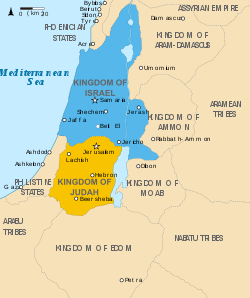Print Article
Author's Bias | Interpretation: conservative | Inclination: dispensational | Seminary: none
 The relationship of Aram - Damascus
to Israel and Judah
© Wikipedia.org |
 Created around 805-775 B.C. |
Excavating at Tell Afis, Syria, French archaeo-Assyriologist Henri Pognon, discovered the basalt stele of Zakkur
(height: 24.5 inches, width: 5.1 inches) in 1903. Originally taller with a figure carved in relief, all that remains
on top of the stele is a pair of feet resting upon a dais / stool.
Significant to the Stele of Zakkur were the Old Aramaic inscriptions on its front (17 lines),
right (28 lines) and left (2 lines) sides.
Founder of the Aramean dynasty at Hamath, a city north of Damascus (213 km / 132 mi), Zakkur sought to annex
Hazrach, a large city in the ancient region of Luhuti. Apish (modern Afis) is thought to be a sacred precinct
within Hazrach.
The distance between Damascus and Aleppo: 343 km / 213 mi
Hamath was south of Aleppo: 134 km / 83 mi
Hazrach was south east of Aleppo: 45 km / 72 mi
Instead of serving as a commemoration of his conquest of Hazrach, king Zakkur of Hamath dedicated the Stele of
Zakkur as a memorial to the storm god Ilu-wer (Aramaic: Baal-shamayin).
The god Baal-shamayin placed Zakkur on the throne of Hazrach.
Threatened by the military forces of 17 city-states led by Bar-Hadad, son of Hazael, king of
Damascus (796-770 B.C.), an appeal is made to the god Baal-shamayin who, communicating through seers, promises
deliverance.
With the defeat of this superior force, Zakkur describes the subsequent building programs he
accomplished in Hazrach especially for the god Baal-shamayin in Apish.
The inscriptions of the Stele of Zakkur portray Zakkur as a pious king who is supported and saved by the god
Baal-shamayin, which in turn legitimizes his usurpation of Hazrach. From a historical standpoint, there is
circumstantial archeological evidence that supports the view that Zakkur's victory was assisted by the Assyrian
king Adad-Nirari III in 796 B.C.
The Stele of Zakkur is significant to the Bible for evidence affirming the influence of the Aram-Damascus kingdom
and two of its kings. Little is known about Zakkur, king of Hamath, because he is not attested in any other
archaeological artifact.
Prominent in the Stele of Zakkur is the name "Bar-Hadad," son of Hazael, king of Damascus.
Equivalent to the Aramean name "Bar-Hadad" is the Bible's reference to "Ben-Hadad" who is mentioned several times
over a significant period of time. Ben-Hadad appears to be a royal title for the king of Aram whose capital is
Damascus.
The meaning of "Ben-Hadad" in Hebrew is "son of the god of Hadad."
Apart from the Bible, ancient Assyrian inscriptions and the Aramean inscribed Stele of Zakkur,
there is no other data that can be used to reconstruct the Aram - Damascus king list. Limiting the king list to
the name Ben-Hadad, the list appears as follows:
According to the Bible and Assyrian inscriptions, the nation of Aram – Damascus appears to have reached its
zenith under Hazael; the Stele of Zakkur indicates the decline of Aram – Damascus with the defeat of Ben Haddad
III and his formidable coalition. The Bible also portrays a similar and detailed ascension and decline of the
nation of Aram – Damascus under these two kings as well.
References:
1. Noegel SB, "The Zakkur Inscription" in The Ancient Near East: Historical Sources in Translation, Chavalas MW, ed., London: Blackwell (2006), 307-311.
2. Edgecomb KP, "The Sons of Hadad" from: Bombaxo.com.
Copyright ©
2018
Helpmewithbiblestudy.org. All rights to this material are reserved. We encourage you to print the material for personal and
non-profit use or link to this site. If you find this article to be a blessing, please share the link so that it may rise in
search engine rankings.